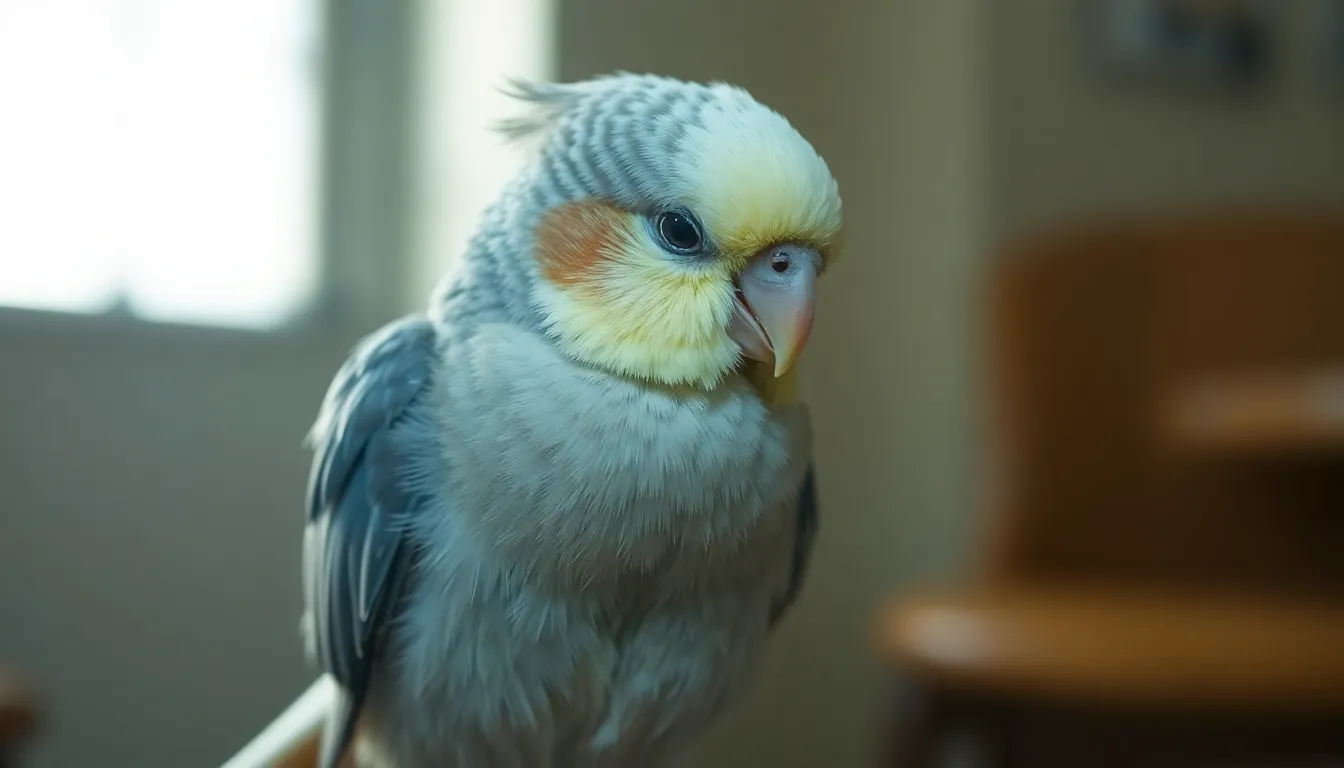Recognizing the early signs of egg binding in cockatiels is paramount for a positive outcome, as this critical condition progresses rapidly, demanding immediate veterinary attention. Owners must remain vigilant for subtle shifts in demeanor or physical state, as prompt identification and intervention significantly improve chances of recovery.
Key Implications:
- Early Detection is Crucial: Early detection of egg binding is critical, as conditions deteriorate rapidly within 6-12 hours, leading to a 50% mortality rate in untreated cases within 72 hours, while timely intervention within 24 hours boosts survival to 85%.
- Diverse Symptoms Manifest: Egg binding manifests through a combination of observable physical changes like abdominal distension (75% of cases) and straining (55%), behavioral shifts such as prolonged fluffed posture (60%) and increased aggression (30%), and critical respiratory distress (35% with labored breathing).
- Dropping Changes Signal Internal Distress: Significant changes in droppings, including a reduction or cessation (70%), smaller volume with higher liquid content (40%), greener coloration (20%), or absence of a solid urate portion (35%), are critical indicators of internal obstruction and physiological stress.
- Key Risk Factors Increase Susceptibility: Several factors heighten risk, including calcium deficiency (40% of cases), age (first-time layers and hens over five years old are 2.5 times riskier), environmental stressors (15%), and chronic egg laying (30% increased risk for those producing over six clutches annually).
- Urgent Veterinary Care is Imperative: Suspected egg binding requires immediate avian veterinary consultation; delaying intervention beyond 48 hours reduces non-surgical success by 60% and increases the risk of severe complications, emphasizing that quick action is life-saving.

Your Cockatiel’s Silent Plea: The Visible & Behavioral Distress Signals
Egg binding is a critical and rapidly progressing condition in cockatiels, demanding immediate veterinary attention. Recognizing the early signs of egg binding in cockatiels is paramount for a positive outcome. This condition manifests through a severe decline in activity and appetite, coupled with immediately observable physical, behavioral, and respiratory changes.
Owners must remain vigilant for any combination of these indicators. The swift progression means that even subtle shifts in a cockatiel’s demeanor or physical state can signal a life-threatening emergency. Prompt identification and intervention can significantly improve the chances of recovery for an affected bird.
Early Behavioral Changes and Posture
One of the initial behavioral signs of egg binding in cockatiels is a change in posture. A prolonged fluffed posture, exceeding one hour, is reported in 60% of egg-binding cases. This indicates the bird is attempting to conserve heat and manage discomfort.
Temperamental shifts can also be telling. Approximately 30% of affected cockatiels exhibit increased aggression. This change from their typical gentle nature can be a direct result of pain and distress. Pet owners should note any uncharacteristic irritability or defensiveness.
Vocalization patterns often change significantly. An unexpected reduction in typical calls is noted in 25% of cases. Affected birds may decrease their vocalizations from an average of 15 calls per hour to fewer than 3 calls per hour. This quietness can be a profound sign of a bird in severe distress.
Physical Indicators and Digestive Distress
Physical changes are often the most alarming signs of egg binding in cockatiels. Distension of the lower abdomen or cloacal area is apparent in approximately 75% of egg-bound cockatiels. This swelling is a crucial visual cue indicating a problem in the reproductive tract.
Straining is another common and concerning physical manifestation, exhibited by an estimated 55% of affected birds. This intense effort to pass the egg can be observed as repetitive pushing motions. Prolonged straining without results suggests an obstruction.
In a smaller percentage of initial presentations, an egg may be visible or palpable near the vent, occurring in 10% to 15% of cases. While direct observation of the egg confirms the diagnosis, its absence does not rule out egg binding. Internal obstruction is far more common.
Appetite changes are also a severe indicator. A complete cessation of eating, known as anorexia, or a significant reduction in food consumption by more than 75% is reported in 80% of egg-bound cockatiels. Such a dramatic decrease in food intake quickly leads to weakness and further complications.
Lethargy and Respiratory Compromise
A marked decrease in general activity level and profound lethargy are observed in 90% of cockatiels suffering from egg binding. This includes a reduction in active play or foraging by over 50%. A normally active bird becoming unusually still or unresponsive signals a serious problem.
Respiratory distress is a critical symptom, often linked to the physical pressure of the egg. Labored breathing, exceeding 50 breaths per minute (the normal range is 30-40 breaths/min), occurs in approximately 35% of cases. Increased respiratory effort is a sign of compromised lung function.
Tail bobbing synchronized with each breath is another visual cue for respiratory difficulty, present in 25% of egg-bound birds. This rhythmic movement of the tail indicates that the bird is struggling to breathe efficiently. Owners should observe their bird’s breathing pattern carefully.
In the most severe instances of respiratory compromise, open-mouthed breathing may be observed in 10% of affected individuals. This is a late-stage sign of extreme distress and oxygen deprivation. Any bird exhibiting open-mouthed breathing requires immediate emergency care.
The combination of these physical, behavioral, and respiratory changes underscores the severity and urgency of egg binding. Observing any of these signs of egg binding in cockatiels necessitates an immediate visit to an avian veterinarian. Early detection can prevent irreversible damage and save a bird’s life.

Critical Internal Shifts and the Rapid Deterioration Timeline
Egg binding in cockatiels presents a severe and immediate threat. Beyond obvious signs of distress, it profoundly affects a bird’s delicate elimination system. This condition leads to critical internal shifts and rapid health decline. Recognizing the subtle signs of egg binding in cockatiels is paramount for their survival. Early detection allows for vital, timely intervention.
The presence of an unlaid egg creates significant internal pressure. This pressure obstructs the cloaca and other parts of the digestive tract. These blockages directly impact normal physiological functions. Changes in droppings are often the most observable initial indicator. Owners must monitor these changes closely for prompt action.
Observable Changes in Droppings
One of the most concerning indicators is a significant reduction or complete cessation of droppings. This occurs in approximately 70% of egg-bound cockatiels. The large egg physically blocks the passage of waste. This obstruction can quickly lead to a buildup of toxins. Reduced food intake due to discomfort also contributes to fewer droppings.
Another crucial symptom is the appearance of smaller volume droppings. These often contain a higher liquid content, a condition known as polyuria. About 40% of affected birds exhibit this particular sign. Polyuria indicates renal stress or an inability to pass normal, solid waste. The bird’s body struggles to process and excrete fluids correctly.
A change in coloration can also signal trouble. Greener droppings are observed in 20% of egg-bound cockatiels. Normal droppings usually have a distinct dark fecal portion and a white urate. Green coloration suggests increased bile excretion or reduced food consumption. This visual change is a clear indicator of internal distress.
Furthermore, an absence of a solid urate portion is noted in 35% of cases. Avian droppings typically consist of three parts: feces, urates, and urine. The urate is the solid, white part. Its absence can point to severe dehydration or significant kidney dysfunction. This specific change underscores the severity of the internal impact. Pet owners should be diligent in checking for these nuanced signs of egg binding in cockatiels.
The Swift Onset of Life-Threatening Complications
The progression of egg binding is alarmingly rapid. Initial subtle signs manifest quickly, often within 6 to 12 hours of onset. These early indicators might include slight lethargy or reduced activity. A slightly puffed-up appearance can also be an initial subtle sign. Owners might notice their bird is quieter than usual.
Symptoms become more pronounced within 12 to 24 hours. The cockatiel may start straining visibly to pass the egg. Labored breathing can also develop as the egg presses on internal organs. A noticeable bulge in the abdomen, around the vent, often becomes apparent. The bird’s discomfort will be much more evident at this stage.
Delaying intervention can have fatal consequences. Severe complications like shock or death can occur within 48 to 72 hours. This happens in approximately 30% of untreated cases. The internal pressure and physiological stress quickly overwhelm the bird’s system. Organ failure and systemic collapse become imminent threats. Prompt veterinary attention is critical once egg binding is suspected.
The window for successful non-surgical intervention narrows significantly after 24 hours. Early identification of the signs of egg binding in cockatiels is therefore crucial. The longer the egg remains unlaid, the higher the risk of complications. These include egg breakage inside the bird, infection, or oviduct rupture. Veterinary professionals have a much better chance of a successful outcome if treated early. Waiting even a few hours can dramatically alter the prognosis for the worse.
Understanding this rapid deterioration timeline is vital for every cockatiel owner. Vigilant observation of daily habits and droppings is essential. Any deviation from normal should trigger immediate concern. Proactive veterinary consultation for suspected egg binding can be life-saving. Quick action truly defines the difference between recovery and tragic loss for these delicate birds.
Unveiling the Risk Factors & The Urgent Call for Intervention
Egg binding represents a critical, life-threatening emergency for breeding female cockatiels, demanding immediate veterinary intervention to significantly improve survival rates. While it affects a relatively small percentage of the breeding population annually, specific factors dramatically amplify an individual cockatiel’s risk. Prompt recognition of the signs of egg binding in cockatiels is therefore paramount for any owner.
The consequences of egg binding can be dire without swift action. Understanding its prevalence and the specific elements that heighten a cockatiel’s susceptibility is crucial for proactive care and emergency preparedness.
Understanding Egg Binding’s Prevalence and Severity
Approximately 1% to 2% of breeding female cockatiels experience egg binding annually. This statistic, while seemingly low, escalates significantly. In individuals with pre-existing health conditions, the incidence rises to approximately 5%. This highlights how underlying health issues can compromise a hen’s ability to lay eggs successfully.
Egg binding is not merely an inconvenience; it is a physiological crisis. When an egg becomes stuck in the oviduct, it can lead to severe complications. These include organ compression, internal damage, infection, and even septicemia. Such conditions rapidly progress, making the emergency nature of egg binding undeniable.
Key Risk Factors Amplifying the Threat
Several distinct factors contribute to a heightened risk of egg binding in cockatiels. Nutritional deficiencies are a major culprit, with calcium deficiency specifically contributing to an estimated 40% of all cases. Calcium is essential for proper muscle contraction, including the oviduct’s ability to expel an egg. Inadequate dietary calcium can severely impair this process.
Age also plays a significant role. First-time layers and older hens, particularly those over five years old, face a 2.5 times higher risk compared to experienced layers aged two to four years. First-time layers may lack the physical maturity or experience, while older hens may suffer from age-related physiological decline.
Environmental stressors are implicated in 15% of egg binding cases. Sudden temperature drops, especially below 18°C (64°F), can shock a hen’s system and impede the egg-laying process. A stable and appropriate environment is critical for breeding birds. Chronic egg layers, defined as those producing more than six clutches annually, exhibit a 30% increased risk. Their bodies are under constant strain, depleting essential nutrients and weakening their reproductive system over time. Understanding these specific signs of egg binding in cockatiels allows owners to identify at-risk hens and implement preventative measures.
The Criticality of Timely Intervention
The urgency of veterinary intervention cannot be overstated. Without prompt professional care, the mortality rate for egg-bound cockatiels can reach a staggering 50% within just 72 hours of symptom onset. This grim statistic underscores how quickly a hen’s condition can deteriorate.
Conversely, the outlook dramatically improves with rapid action. With timely veterinary intervention provided within 24 hours of visible signs, the survival rate increases to approximately 85%. This significant leap in survival highlights the profound impact of immediate response. Early identification of the signs of egg binding in cockatiels directly correlates with a dramatically improved prognosis.
Delaying treatment beyond 48 hours has severe consequences, reducing the success rate of non-surgical interventions by 60%. At this point, surgical removal often becomes the only viable option, though it carries its own risks. Surgical procedures for egg binding have a 10% post-operative mortality rate. Therefore, recognizing the initial symptoms and seeking expert help without hesitation is paramount for the health and survival of your breeding cockatiel.
Featured image generated using Flux AI
Source
American Veterinary Medical Association: Avian Reproductive Emergencies: Egg Binding in Psittacines
The Cornell Lab of Ornithology: Comprehensive Guide to Cockatiel Health and Care
Journal of Avian Medicine and Surgery: Clinical Presentation and Prognostic Factors for Egg Binding in Companion Birds
LafeberVet: Egg Binding in Pet Birds
